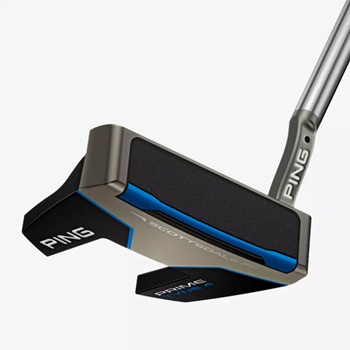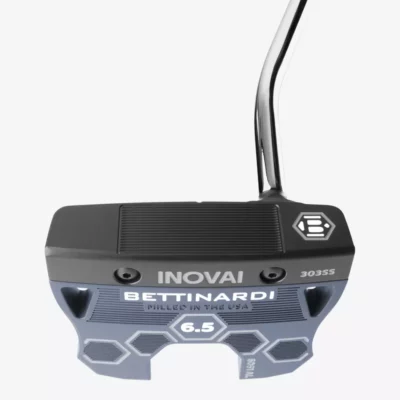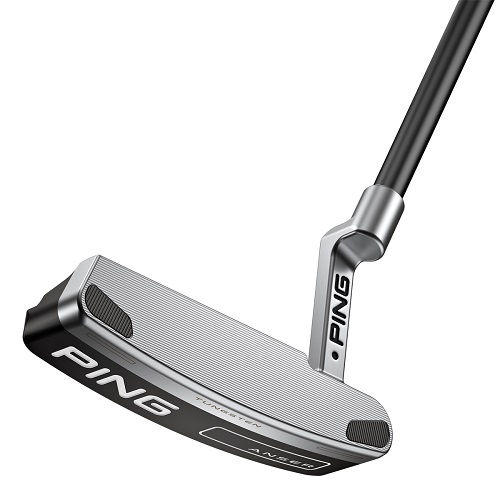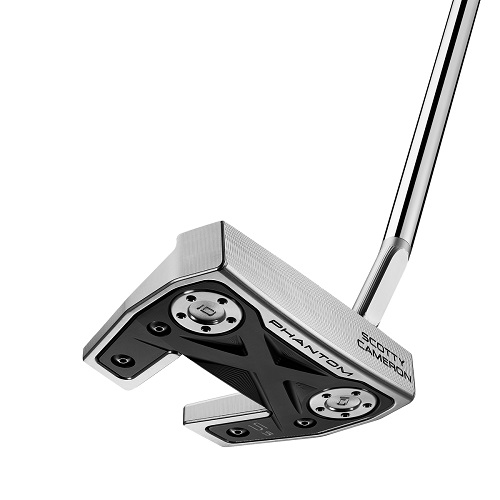Updated July 1, 2025. This article was thoroughly audited by multiple golf experts and coaches for its accuracy. You can read more about our rigorous testing protocol here.
One of the most neglected areas of the golf game by beginners is the putting green.
By using a poorly made putter, beginners can sabotage their short game, causing them to post higher scores and hindering their potential growth.
Our list of the best putters for beginners provides players early in their careers the opportunity to play with a putter that will help their game rather than hinder it.
These high forgiveness putters offer clear alignment aids along the top to help you center the golf ball on the face, plus provide an impressive feel to help you gain confidence on the green.




Featured Recommendations
Last updated on 2025-07-02. The links are affiliate links. Product images are served from Amazon Product Advertising API.
Table of Contents
Best Putter for Beginners 2025
Odyssey Ai-One Square 2 Square Jailbird Cruiser Putter
Best Mallet Putter for Beginners

Check Price on Amazon
Check Price on PGA Tour Superstore
Check Price on Global Golf
Specifications
- Head: Mallet
- Loft: 3 degrees
- Length: 38 inches
- Head Weight: 380 grams
Pros
- Mallet design keeps the face square during the stroke
- Extended grip offers balance and stability
- Ai-ONE insert provides exceptional distance control
Cons
- Unique design requires an adjustment period
We’ll be honest, when we first pulled the Odyssey Ai-One Square 2 Square Jailbird Cruiser from its headcover, we were skeptical.
We thought this might be too much putter for beginning golfers due to the unique zebra color scheme and odd head shape.
But after spending time on the practice green, we quickly became believers.
What we love most about this putter is how it practically eliminates those frustrating pushes and pulls that can derail a beginner’s confidence.
For developing golfers, this putter offers something extraordinary: the ability to easily produce a putting stroke that automatically stays on plane.
The zero-torque design means beginners don’t have to worry about manipulating the face through impact, allowing them to focus on pace and reading greens instead of mechanics.
We immediately improved our start line accuracy during our practice time, which is often the biggest hurdle for new players.
We found that golfers who struggled with short, jerky strokes suddenly developed smoother, more consistent putting rhythms after just a few practice sessions with this design.
The counterbalanced design also helps teach proper putting fundamentals without forcing it.
And for beginners, the design naturally develops better shoulder rotation and tempo because the putter’s weight distribution encourages the correct motion.
An easy choice for the best putter for beginners, the Ai-One Square 2 Square Jailbird Cruiser delivers consistent, reliable performance straight from the box.
Cleveland HB Soft 2 Black 1 Putter
Best Value Blade Putter for Beginners

Check Price on Amazon
Check Price on PGA Tour Superstore
Check Price on Global Golf
Specifications
- Head: Blade
- Loft: 3 degrees
- Length: 34-35 inches
- Head Weight: 355 grams
Pros
- Outstanding ball speed and forgiveness across the face
- Premium black satin finish looks professional
- Exceptional value with tour-level construction
Cons
- Single alignment line may not provide enough guidance
The Cleveland HB Soft 2 Black 1 surprised us in the best possible way. At first glance, we expected just another budget blade putter, but it punches well above its weight class.
At first glance, the face immediately caught our attention. It’s remarkably soft for a steel-faced putter, creating that satisfying full sound at impact that builds confidence over crucial short putts.
This putter excels at teaching beginners proper distance control, which is often their biggest weakness.
The Speed Optimized Face Technology normalizes ball speed across the entire face, meaning even toe hits don’t roll dramatically short or long like they would with traditional putters.
We believe beginners will achieve a much better pace with the HB Soft Black 1 because even off-center strikes produce a more predictable roll.
The simple single-line alignment system also helps developing golfers focus on the fundamentals without too much visual distraction.
Many beginners get distracted by complex alignment aids, but this clean design encourages them to develop their own feel for proper setup.
When it comes to value, there are very few putters that deliver the performance for the cost than the HB Soft 2 Black 1 from Cleveland.
Ping Scottsdale Prime Tyne 4 Putter
Most Forgiving Mallet for Beginners
Check Price on Global Golf
Specifications
- Head: Mallet
- Loft: 3 degrees
- Length: 33-36 inches
- Head Weight: 365 grams
Pros
- Maximizes MOI and stability for ultimate forgiveness
- Lightweight face insert creates a soft feel with consistent ball speeds
- Very affordable for a premium Ping putter
Cons
- Larger head size may be intimidating for golfers
The Ping Scottsdale Prime Tyne 4 is everything we want in a beginner-friendly mallet: stable, forgiving, and confidence-inspiring.
From the moment we addressed our first putt, the twin-fork design created an incredibly solid feedback that’s hard to describe until you experience it.
We found ourselves naturally squaring the face thanks to the subtle color blocking, which creates perfect contrast without being distracting.
The thinner insert delivers a surprisingly soft feel for such a high-MOI design, and we loved how it seemed to grab the ball and start it rolling without skidding.
This putter definitely transforms beginners into more confident putters by virtually eliminating the fear of off-center strikes.
For golfers who leave everything short, we believe this putter enables them to start attacking the hole with more confidence due to its roll quality and forgiveness.
The visual design also helps the learning process for proper alignment and setup.
The color contrast naturally draws your eye to the correct ball position, while the substantial head size creates a sense of security at address.
Beginners often struggle with confidence over crucial putts, but this putter’s design and clear sight lines help newbies commit to their stroke instead of second-guessing their alignment mid-stroke.
Bettinardi Inovai 6.5 Putter
Best Forked Mallet Putter for Beginners
Check Price on Global Golf
Specifications
- Head: Mallet
- Loft: 3 degrees
- Length: 33-36 inches
- Head Weight: 360 grams
Pros
- Balances premium feel with high MOI performance
- High-grade face milling delivers immediate forward roll while reducing skid
- Top-tier exterior finish enhances visibility
Cons
- Premium pricing places it at the top end of the beginner market
While it might be overkill, the Bettinardi Inovai 6.5 should be considered by beginners because it’s so well-designed and buttery smooth on the course.
Featuring the patented hexagonal design and those distinctive fangs creates a unique look that offers a modern and dynamic appearance.
We were initially concerned the busy look might be distracting, but after a few putts, the triple sight lines actually helped us dial in our alignment better than expected.
The bi-metal construction creates a superb contrast in both appearance and feel, and the stainless steel face delivers that crisp feedback we love with magnificent stability.
For beginners serious about improving their putting, this putter offers professional-level feedback that accelerates learning.
The milling provides immediate confirmation when you strike the ball squarely on the center of the face, helping new golfers understand what a pure stroke feels like.
The premium construction also builds lasting confidence that cheaper putters simply can’t match.
We found that golfers using this putter approached each putt with greater focus and commitment, knowing they had tour-level golf equipment in their hands, which translated directly into better performance and faster skill development.
Ping Anser Putter
Most Forgiving Blade Putter for Beginners
Check Price on Global Golf
Specifications
- Head: Blade
- Loft: 3 degrees
- Length: 33-36 inches
- Head Weight: 345 grams
Pros
- Milled face offers the softness and gentle roll
- High contrast alignment guide helps center the putt
- Lightweight graphite shaft offers exceptional feel
Cons
- Does not come with a steel shaft option
Ping’s most popular putter, the Anser, gets an update with a milled face, lightweight graphite shaft, and high-contrast alignment guide.
This high MOI putter offers a firmer feel than comparable blade-style options but delivers the touch you need from anywhere on the putting surface.
It provides exceptional balance with heel and toe weights that give room for an arcing stroke yet can return the face to square at impact with regularity.
The slight difference between the milled face and shaft makes the Anser an outstanding offset putter for beginners looking for a blade-style putting solution.
While we wish this golf club had a stainless steel shaft option, it’s hard to argue that the Anser doesn’t deliver the lightweight feel that helps with long-range putting, a significant problem for most beginners.
Although it’s a classic, the latest version of the Ping Anser delivers modern technology to the beginning golfer, making it an easy choice as one of the best putters for beginners looking to play a blade putter.
Scotty Cameron Phantom X 5.5 Putter
Best Luxury Putter for Beginners
Check Price on Global Golf
Specifications
- Head: Forked Mallet
- Loft: 3.5 degrees
- Length: 33-35 inches
- Head Weight: 340-370 grams
Pros
- Updated Pistolero putter grip
- Stationary sole weights offer customization and balance
- Milled face delivers softness and improved feel
Cons
- Expensive putter might be too much for beginners
From Scotty Cameron comes the Phantom X 5.5, our choice for the best putters for beginners when it comes to playing with tour-level golf equipment.
At address, it features a forked mallet appearance with a broad alignment guide, making it a dependable putter for helping beginner golfers improve their accuracy.
Additionally, the milled face provides a soft feel, helping you sink more putts from 10 to 25 feet. The milling creates more friction on the ball, creating an immediate forward roll that stays along the target line.
After using the Phantom X 5.5 on the greens, we can firmly attest that this mallet ranks among the best putters on the market for producing dependable roll with controllable distance.
When assembling a set of golf clubs, some amateurs overlook how high-quality golf equipment can shorten the learning curve.
While a putter like the Phantom X 5.5 comes with a high cost, the improvement you can make on the greens with this superb putter is worth your consideration.
Wilson Staff Infinite Buckingham Putter
Best Feel Mallet for Beginners

Check Price on Amazon
Check Price on PGA Tour Superstore
Specifications
- Head: Mallet
- Loft: 3 degrees
- Length: 33-35 inches
- Head Weight: 365 grams
Pros
- Dark matte finish contrasts nicely with the ball
- Double milled face produces forgiveness
- Simplified alignment guide delivers accurate rotation after impact
Cons
- Design lacks an impressive modern appearance
From the Wilson Staff collection comes the Infinite Buckingham putter, a mallet that offers sophisticated loft technology to help control the putt’s length and produce better accuracy from short and long-range distances.
What we liked about the Buckingham is that the company moved the balance point closer to the hands.
This feature provides a better, more controllable stroke, especially when putting off the green.
We also believe Buckingham’s milled face helps this offset putter produce a better feel and more responsiveness, which helps beginners learn how to control their putting.
But even though this putter comes from the Wilson Staff collection, the criss-cross alignment design doesn’t offer the “wow” factor most golfers want in a putter.
TaylorMade Spider GT Max Putter
Best Distance Control Putter for Beginners

Check Price on Amazon
Check Price on PGA Tour Superstore
Check Price on Global Golf
Specifications
- Loft: 2.5°
- Lie: 70°
- Shaft Length: 34”-35”
- Head Weight: 365 grams
Pros
- Adjustable sliding weights offer total customization
- Extremely versatile with outstanding performance
- Precise weighting with stable, high MOI
Cons
- Strange head shape can be distracting for beginners
TaylorMade’s Spider GT Max offers a forked mallet that provides high MOI with unmatched stability. With a wide alignment guide along the top of the head, golfers can visualize the putt before they bring the putter back.
The sliding weight along the bottom of the putter remains the best feature of the putter. With two 40-gram weights along the forks, players can customize the head to produce more consistent putts that find the cup.
Great for beginners who prefer a heavier mallet, the Spider GT Max features a smooth, consistent roll behind a black TPU insert that generates quick forward roll.
How We Tested the Putters
Our testing process begins with a specification check and initial assessment of each eligible putter.
We verify loft, lie angle, head weight, and shaft length measurements to ensure each putter meets its manufacturer’s claims.
During our initial handling, we evaluate build quality, finish consistency, and overall feel before moving to the performance portion of our testing.
Next, we collect a comprehensive range and Trackman data under controlled conditions.
Using launch monitor technology, we measure ball speed consistency, launch angle, and spin rates across different impact locations on the face.
We conduct putting sessions from varying distances, looking at distance control and accuracy to establish a performance baseline for each model.
Our on-course real-world testing takes place with different green speeds and conditions.
We play full rounds with each putter, focusing on performance in a wide range of on-course situations that beginners typically encounter when playing.
During this testing, we look at how putters perform during actual rounds where confidence, alignment aids, and forgiveness become crucial factors for scoring.
Finally, we head back to the lab to evaluate and make our final decisions based on our data and our overall feelings on each putter.
We compare performance against price and assess long-term durability through our extended testing while evaluating each putter’s suitability for beginner golfers.
How to Choose the Best Beginner Putter
Looks
The way a putter sits behind the golf ball and sets up to the target line is of paramount importance when judging the effectiveness of a putter.
There are numerous different alignment lines/dots/aids designed with one thing in mind: hit the golf ball in the right direction.
Some golfers want minimal alignment aids, whereas others need big, long lines or prefer a unique system like a 2-ball putter or a SeeMore offer.
My judgment on looks is based on first impressions:
- How it looks when you pick it up
- How it looks when you set it down behind the ball
- How well does it help you focus on the target line
- The craftsmanship involved in making the putter
Feel
Feel might be the hardest element of putting to define. There are numerous inserts and metals used in putters to offer golfers a wide array of feels at impact.
And on top of that, the type of golf ball you choose to use can affect feel as well!
For example, a rock hard distance ball like a Top Flite will feel quite different from a soft, high-compression ball like a Wilson Staff Duo.
For these tests, we used the most popular ball on the PGA Tour, the Titleist ProV1x, a ball that suits a wide cross-section of players.
The combination of distance, feel, and spin offered by the ProV1x is the reason it revolutionized the golf world upon its introduction, making it a great ball to test putters with.
An often-overlooked element of feel is sound, so we’ve incorporated sound into this feel rating.
For example, we’ve used putters that made a lot of putts but had such an off-putting sound that we had to take them out of play.
Roll Quality
One of the most essential features of a putter is its ability to get the ball rolling quickly.
This may seem like an obvious statement, but you’d be surprised at how many putters cause the ball to skid or hop before it finally starts rolling properly.
These initial skids and hops can wreak havoc on both the accuracy and speed of the putt.
The goal is to get the ball rolling smoothly as soon as possible because a rolling ball carries a good amount of inertia and is less likely to be affected by the grain and impurities of the green.
If the ball is skidding, bouncing, or just not rolling smoothly, it’s more likely to be knocked off line or come up short of the hole.
Forgiveness
You’d think that a putting stroke should be an easy, short, repeatable motion that results in sweet spot contact every time.
The putter only moves a few inches back and through, right?
Well, it’s a whole lot more complicated than that. Even the best, smoothest putting strokes in the world produce mis-hits.
And in a game where the target is a mere 4.25” in diameter, precision is the name of the game.
So we’re looking for putters that will produce good results no matter where the putt is struck on the face.
If you hit a sweet spot with one stroke and then miss it with the next, ideally, you’d still like both putts to roll the same distance and along the same line.
A putter with poor forgiveness will leave mis-hits woefully short or bending offline.
A higher level of forgiveness equals more putts made, especially in high-pressure situations when your stroke might get a little wobbly or tentative.
Value
The last criterion here is value. Many beginner and intermediate golfers are just getting into the game and need to upgrade their whole bag.
While it’s tempting to spend $600 on a driver and $400 on a putter, is it really worth it?
The best Scotty Cameron putters may be ubiquitous on tour, but can a $100 putter get the job done and still leave you with enough left over for a lesson or two?
With green fees increasing every year, spending your dollars wisely is important.
If you’re playing for big money, maybe it’s worth it to splurge on a putter. But what if there’s a putter out there that fits your needs for a much lower price?
Or you may be the type of player who constantly changes putters. You’ve got one in your bag and ten in your garage.
The putter that couldn’t miss yesterday suddenly stops working, so you hop online and buy yourself a new weapon for the greens.
Either way, you’re looking for a great bang for your buck! We’ve put in the time to make sure you’re getting your money’s worth with these best budget putters.
Check our detailed guide: How to Choose a Putter
Expert Advice
Many first-time golfers don’t realize how vital the putter is for their game. A golfer can expect to take anywhere from 30 to 40 putts per round, making the putter the most used club in their bag.
The putter offers terrific value for the cost, considering how often it is used during an 18-hole round.
While all golfers should stay within their budget, allocating more money for a higher-end putter does pay off in the long run due to its frequent usage and the importance of putting in lowering scores.
If you’ve heard the adage, “you get what you pay for,” in the case of the putter for new golfers, it is actually true.
Recommended: 15 Best Golf Newsletters
Frequently Asked Questions

What type of putter should a beginner use?
Mallet putters tend to have better accuracy for inexperienced golfers, making them the best style for beginners.
Mallet putters offer a heavier weight, better distance control, and the ability to move the head on a straight-back, straight-through putting stroke that helps eliminate errors and mis-hits.
Mallet putters also feature large alignment lines to help beginner golfers find the center of the putter face, creating a pure roll and increasing the likelihood of made putts from shorter distances, ultimately saving strokes.

Should a beginner use a blade or mallet putter?
We believe a mallet-style putter offers a better chance for beginning golfers to make more putts from short and mid-range distances, where many strokes pile up per round.
While most golfers may think that strokes are lost on the tee box and from the fairway, the truth is that missing short, makeable putts causes high scores to inflate.
Blade putters, although lighter, require more consistency and experience because these putters demand an arc stroke where the putter face comes to the inside before returning to square at impact. This stroke causes more off-center strikes for beginner golfers.

What is the most forgiving putter type?
For high handicappers and beginners, mallet putters offer the most forgiveness. A mallet is a high MOI putter, helping new golfers keep the face square throughout the putting stroke.
Due to its size, shape, and weight, the mallet is an ideal putter for beginners, helping them achieve better consistency, prevent bouncing and skipping after impact, and allow for contact from the sweet spot for a more consistent roll.
The best putters for beginners provide exceptional feel, dependable ball speed, and the correct loft technology to help produce better forgiveness.

How do I know if I need a mallet or blade putter?
To determine if you need a mallet or blade putter, consider your putting stroke. Blade putters are often preferred by golfers with an arc in their stroke, while mallet putters are generally recommended for those with a straighter back-and-through motion.
Ultimately, the best choice depends on what feels most comfortable and helps you consistently align and control your putts.

What is the most forgiving putter in golf?
The Odyssey White Hot OG Rossie wins our award as the top putter for providing the most forgiveness. Featuring their patented White Hot Insert, the OG Rossie delivers a soft feel, a smooth, consistent stroke with top-tier forgiveness, and pure roll.
The White Hot OG Rossie also features a wide alignment guide that perfectly aligns with the outer edges of the golf ball, helping beginning golfers find the sweet spot with consistency.
But if the ball strikes off-center, the putter’s stability and high MOI work hard to maintain ball speed and keep the putt along the target line.
The putter also features perimeter milling, which creates friction with the ball’s outer layer to produce an immediate forward roll without hopping, allowing golfers to control the ball more easily.





